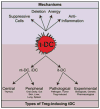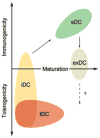How tolerogenic dendritic cells induce regulatory T cells
- PMID: 21056730
- PMCID: PMC3050492
- DOI: 10.1016/B978-0-12-380995-7.00004-5
How tolerogenic dendritic cells induce regulatory T cells
Abstract
Since their discovery by Steinman and Cohn in 1973, dendritic cells (DCs) have become increasingly recognized for their crucial role as regulators of innate and adaptive immunity. DCs are exquisitely adept at acquiring, processing, and presenting antigens to T cells. They also adjust the context (and hence the outcome) of antigen presentation in response to a plethora of environmental inputs that signal the occurrence of pathogens or tissue damage. Such signals generally boost DC maturation, which promotes their migration from peripheral tissues into and within secondary lymphoid organs and their capacity to induce and regulate effector T cell responses. Conversely, more recent observations indicate that DCs are also crucial to ensure immunological peace. Indeed, DCs constantly present innocuous self- and nonself-antigens in a fashion that promotes tolerance, at least in part, through the control of regulatory T cells (Tregs). Tregs are specialized T cells that exert their immunosuppressive function through a variety of mechanisms affecting both DCs and effector cells. Here, we review recent advances in our understanding of the relationship between tolerogenic DCs and Tregs.
Copyright © 2010 Elsevier Inc. All rights reserved.
Figures




References
-
- Steinman RM, Hawiger D, Nussenzweig MC. Tolerogenic dendritic cells. Annu Rev Immunol. 2003;21:685–711. - PubMed
-
- Roncarolo M, Battaglia M. Regulatory T-cell immunotherapy for tolerance to self antigens and alloantigens in humans. Nat Rev Immunol. 2007;7:585–598. - PubMed
-
- Zou W. Regulatory T cells, tumour immunity and immunotherapy. Nat Rev Immunol. 2006;6:295–307. - PubMed
-
- Türeci O, Bian H, Nestle FO, Raddrizzani L, Rosinski JA, Tassis A, Hilton H, Walstead M, Sahin U, Hammer J. Cascades of transcriptional induction during dendritic cell maturation revealed by genome-wide expression analysis. The FASEB Journal. 2003;17:836–847. - PubMed
-
- McIlroy D, Tanguy-Royer S, Le Meur N, Guisle I, Royer P-J, Léger J, Meflah K, Grégoire M. Profiling dendritic cell maturation with dedicated microarrays. J Leukoc Biol. 2005;78:794–803. - PubMed
Publication types
MeSH terms
Grants and funding
LinkOut - more resources
Full Text Sources
Other Literature Sources

